It’s hot. We don’t have air conditioning up here in Vermont, and this week we may wish we did. I’ve got a recipe for some buns to support your grilling and such this summer. Toothier than a hot dog bun, these are perfect for a bratwurst with sauerkraut or a grilled kebab with yogurt, hot sauce, and fresh herbs. In any case, stay cool, y’all!
Also, I’ll keep plugging an opportunity for you to support the newsletter in tangible ways — thanks to all the folks that got on board, helping to keep these recipes and words accessible to everyone. If you missed the “Hello from Vermont” newsletter last week, check that out, too.
This past weekend was Father’s Day. From coast to coast, with grill smoke rising, and piles of puns, we paused to hug, appreciate, and honor the guys we call Dad, Daddy, Papa, or just “old man.”
In support of the occasion, I worked on a pretzel roll formula with some sourdough culture, beer for a bit of hydration, and a little whole grain flour.
Between making the dough, preparing condiments, and shooting pictures, I had a second to reflect on my experience of fatherhood. From challenging early days, to feeling needed and purposeful, to now having college kids and only Arlo left at home, it was an opportunity to feel my way through a couple decades and consider this: Who am I as a father?
The truth is that I don’t know. Growing up in the 1970s and 1980s, we were put on course to be a certain type of dad. From reruns of My Three Sons to the old roles and models that show up everywhere, the cultural expectation was that we “Dad” a certain way: distant, unbending, stoic — you know the guy. And while much of the “wait until your father gets home” trope is cartoonish, like it or not, bits of that stuff stick.
While I feel like I’ve skipped some pitfalls, thanks to my own dad and his example, sometimes in avoiding the old norms I’m left unsure how to proceed: We know what we shouldn’t be as men, but subtracting that, what’s left? Who am I?
Again, I don’t know. But here’s my experience. The less I “Dad,” the closer I get to the best part of parenting: not parenting. When I remove the stereotype, Dad becomes someone that is both more, and less, simultaneously. More available, less prescriptive. More of a listener, less of a talker. More compassionate, less quick to judge. With less parenting on board, we are more. And in that space — the place where there is nothing but our humanity — my connection to my children, and even my parents, can grow. And the bond, that sense that we would choose each other to share our short, sweet lives, family or not, parent or not, Father’s Day, or not … is the best part of all.
Enjoy the recipe.
Martin
Pretzel Rolls
Yield: Five large rolls plus five small rolls
Water, warm, 150g
Beer, room temperature, 150g (I used an IPA for the hops and bitterness. Use water or a NA beer if you prefer.)
Sugar, 14g
Yeast, instant, 3g (1 t)
Egg, whole, 50g (one medium)
Butter, melted, 28g (bacon fat, rendered chicken fat, or lard work well, too)
Sourdough culture* (liquid levain), 54g (see my notes, below)
In a medium bowl whisk everything together until homogenous and frothy, then gather the dry ingredients.
*A couple quick notes about the sourdough. While you can set a sourdough preferment (all- purpose flour, 20g, water, 20g, and culture, 14g) and let it ripen overnight, you may also use discard. Or, lacking sourdough culture you can make a poolish (all-purpose flour, 27g, water, 27g, a pinch of yeast) and let it ripen overnight. For those of you who want the full sourdough treatment (you know my feelings on this: with or without commercial yeast — it’s all baking), you may omit the yeast but the bulk rise and final proof should both be extended significantly as the quantity of flour in the preferment is relatively low.
Bread flour, (12.7% protein), 513g
Whole grain flour, 27g (this can be anything from whole rye to whole wheat, spelt, or semolina, even cornmeal, it’s purpose is to bring color, texture, and flavor)
Salt, fine, 8g
Stir the dry ingredients into the wet with the handle end of a wooden spoon, then switch to a flexible scraper. Clean the sides of the bowl as you press and fold the dough. Once homogeneous with no dry spots remaining, cover and rest for 20 minutes. During the rest the dough will transform from a shaggy mass, strengthening as the flours hydrate.
After mixing and the initial 20 minute rest, the dough will rise for two hours. During that period you’ll fold twice, once at the beginning and once at the halfway point.
After the rest, using a wet hand, firmly knead the dough in the bowl until smooth, about one minute. Cover and rest for one hour, then perform a second bowl fold. Lift the dough from the side, stretch upwards, then press into the center. Repeat this motion 8 to 10 times, working your way around the dough. Cover and rest until marshmallowy, about one hour.
There are many options for the divide. I’ve gone with two sizes: A smaller blunt-sided roll at 75g and a longer, elliptical shape at 100g. The smaller roll is a perfect size for a single grilled sausage. The larger roll is good for a “grinder” or “hero” sandwich and too long for a standard hot dog. You can also consider making rounds for burgers or other uses. The only additional note here is that these are toothier than a traditional brioche-based hot dog or hamburger bun. A sturdy sausage with sauerkraut or, as I’ve done in the picture at the top, a grilled sausage with lettuce, mustard, celery salt, pickled onions, and tart relish is perfect. As always, make it your way.
To divide the dough, place on a well-floured surface and cut into pieces weighing 75g or 100g each.
To shape the large pieces, gently stretch into rectangles roughly 5” wide. Roll from top to bottom, pressing, tensioning, and sealing as you go. (I’ll get a video of this up on my Instagram.) Roll gently to taper.
To shape the smaller pieces, gently stretch the dough into rectangle roughly 4” wide. Fold the sides to the middle and press to seal. Then roll down from the top, pressing, and tensioning as you go. The final shape should be a nice cylinder with no taper.
Proof the pieces covered until they are noticeably lighter and marshmallowy, about an hour. In cooler seasons they might take 90 minutes and, in the heat of summer, as little as 45 minutes.
About 45 minutes before baking, prepare the boiling liquid, preheat the oven to 450°F, and gather tools. You’ll need: A slotted spoon for transferring the rolls after boiling, a baker’s lame for scoring the rolls, coarse salt (pretzel salt or kosher salt) for garnish, and two half sheet trays lined with parchment and sprinkled with a light, even coating of cornmeal or semolina.
Water, 1,800g (about 2 quarts)
Salt, 18g
Baking soda, 57g (about 1/4 cup)
In a large pot combine the water, salt, and baking soda and bring to a low boil — small bubbles are fine, a rolling boil is too much.
Quick note here to say that if you want to dip in a 3% to 4% lye solution, go for it. I actually prefer the flavor, color, and shine that lye-dipped pretzels have. I prescribe the gentle boil method here as most people don’t have lye.
Once proofed, gently lower the rolls into the hot water with a slotted spoon. I have found that working with half the batch at a time is best. (As soon as the rolls have boiled, be ready to move quickly with the subsequent steps of scoring, salting, and loading them into the oven without delay as they will collapse if left too long.)
Using your hands and working gently, transfer the rolls to the hot water, lowering them into the liquid seam-side-up. Boil for about 30 seconds per side, gently turning them at the halfway point. After the brief boil, place them seam-side-down onto the trays, distributing them evenly. Garnish with coarse salt then score with the lame and load into the oven. While the first batch begins to bake, boil and process the remaining rolls.
Bake the rolls until chestnut brown and beautiful, 18 to 22 minutes, rotating as necessary (front to back, top to bottom). If you’re unsure about how much color is appropriate, have a look at the photos here for reference. The pH of the baking soda in the water (similar to lye) helps the rolls to brown during baking — don’t be fooled into thinking they are burning, the full bake and robust color is appropriate and optimal. And, they will soften after the bake.
I don’t think you need much help for toppings but I’ll offer a couple tips for filling the rolls. As I mentioned previously, these rolls take hearty fillings and strong flavors very well. Mustards, spicy sausages (meatless options exist and are delicious), and pickled things — even shredded pork or chicken with crunchy slaw and vinegary hot sauce would be great. For maximum texture and deliciousness, I tend to enjoy them even more when I split the bun, butter, and toast it, cut side down on a hot pan or griddle. The toasting is especially helpful for any rolls that remain after a day or so, just to refresh them a little. This could also be done on a grill if it’s already hot. Enjoy!
Happy baking,
Martin



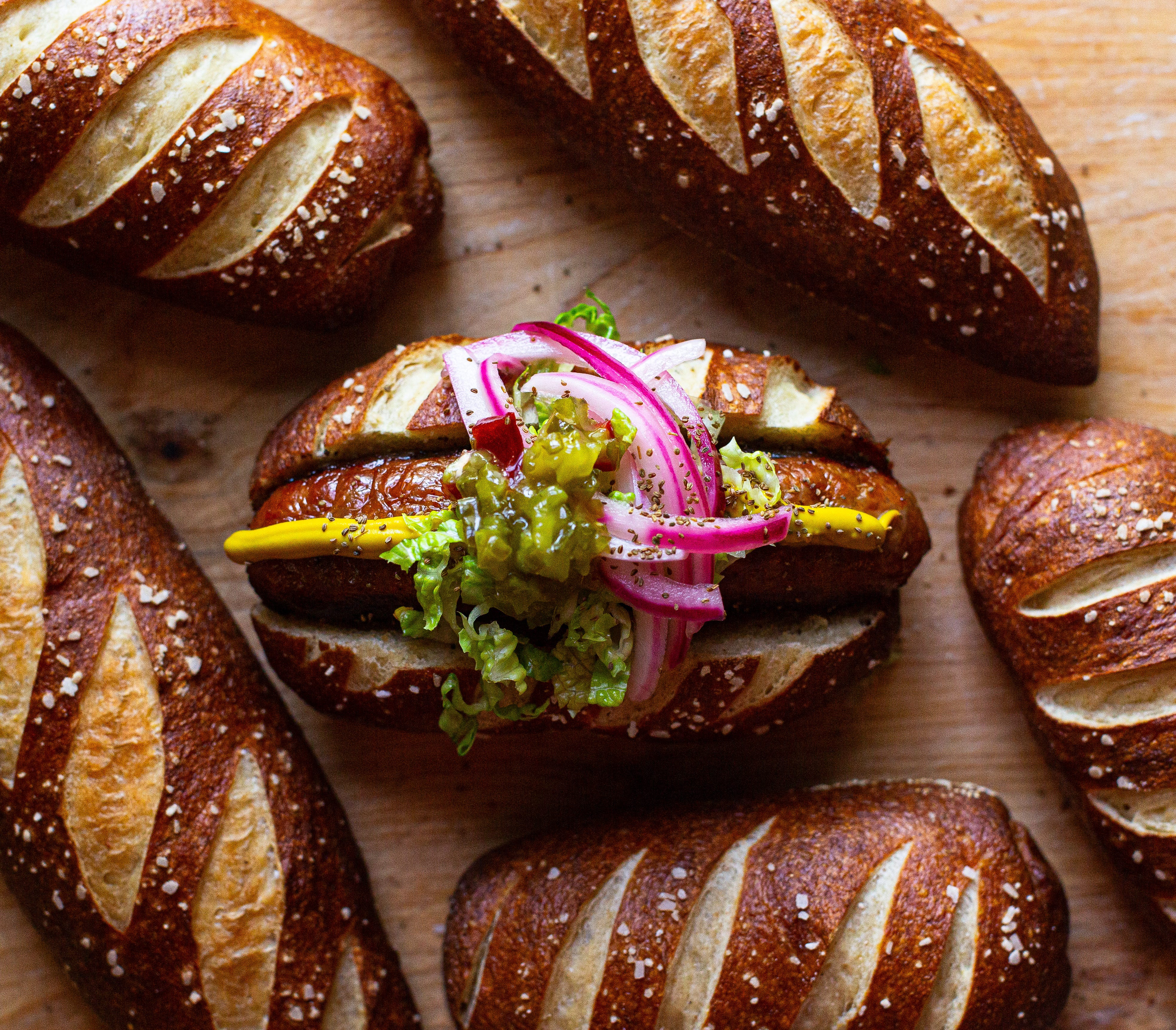
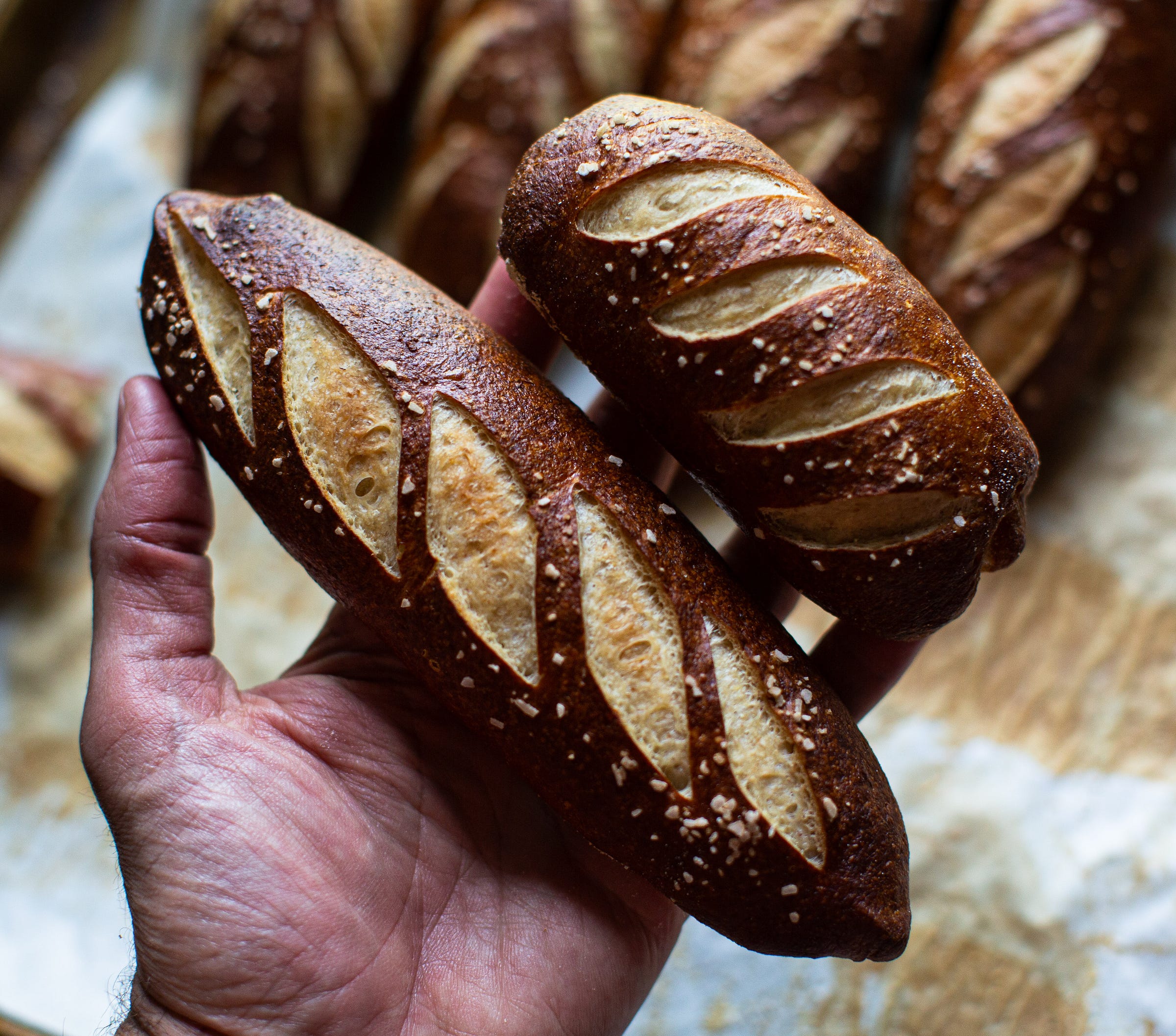
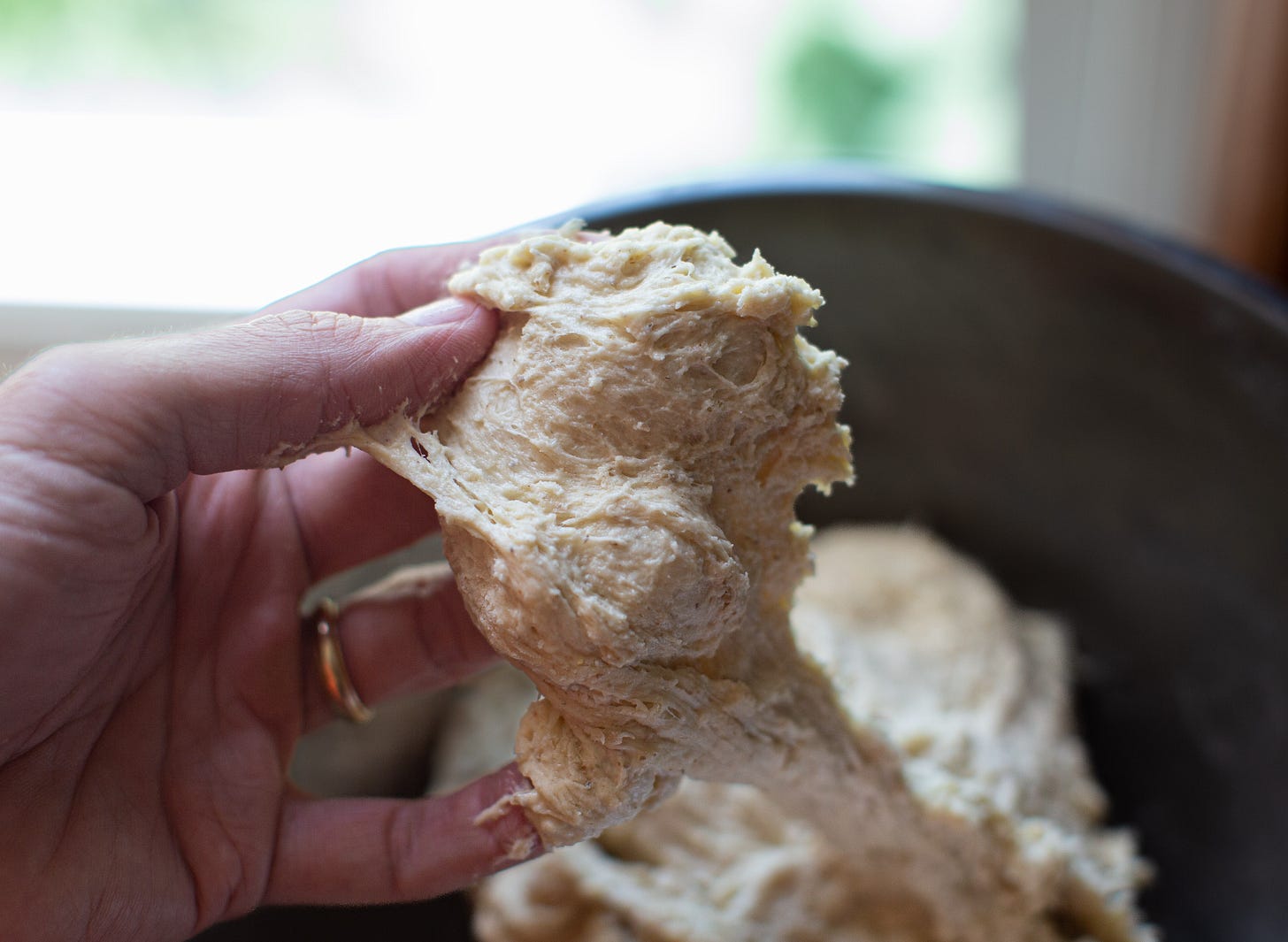
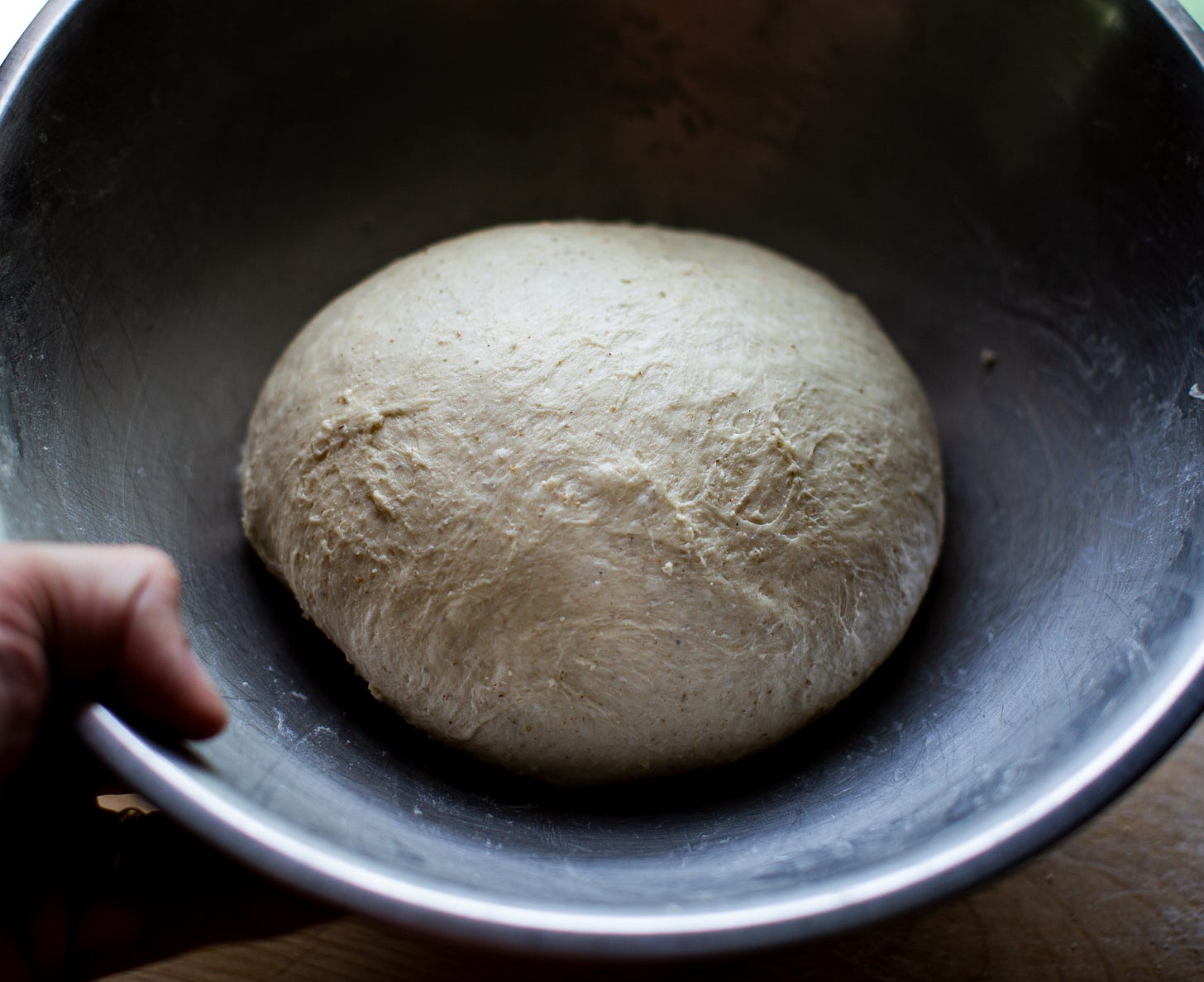

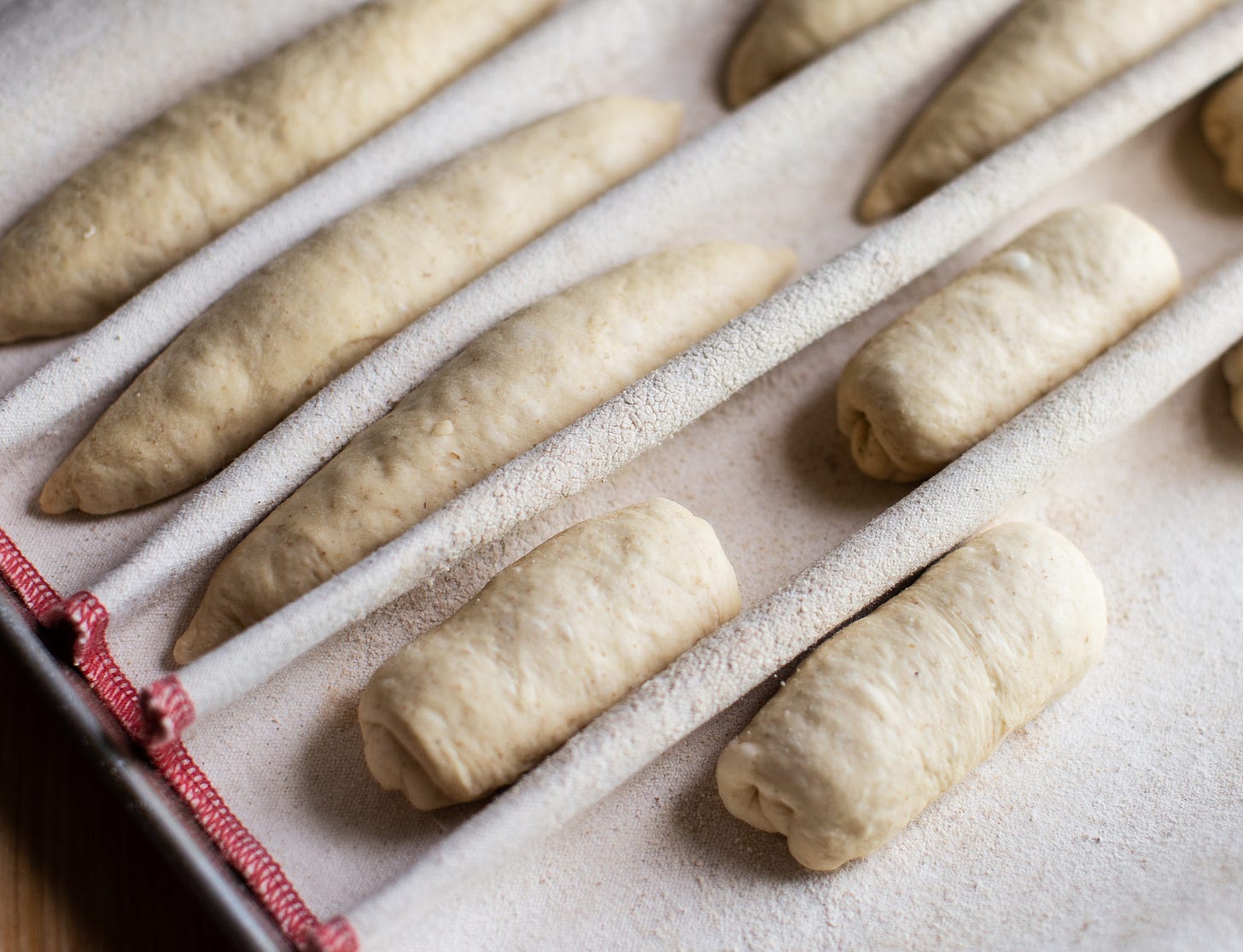
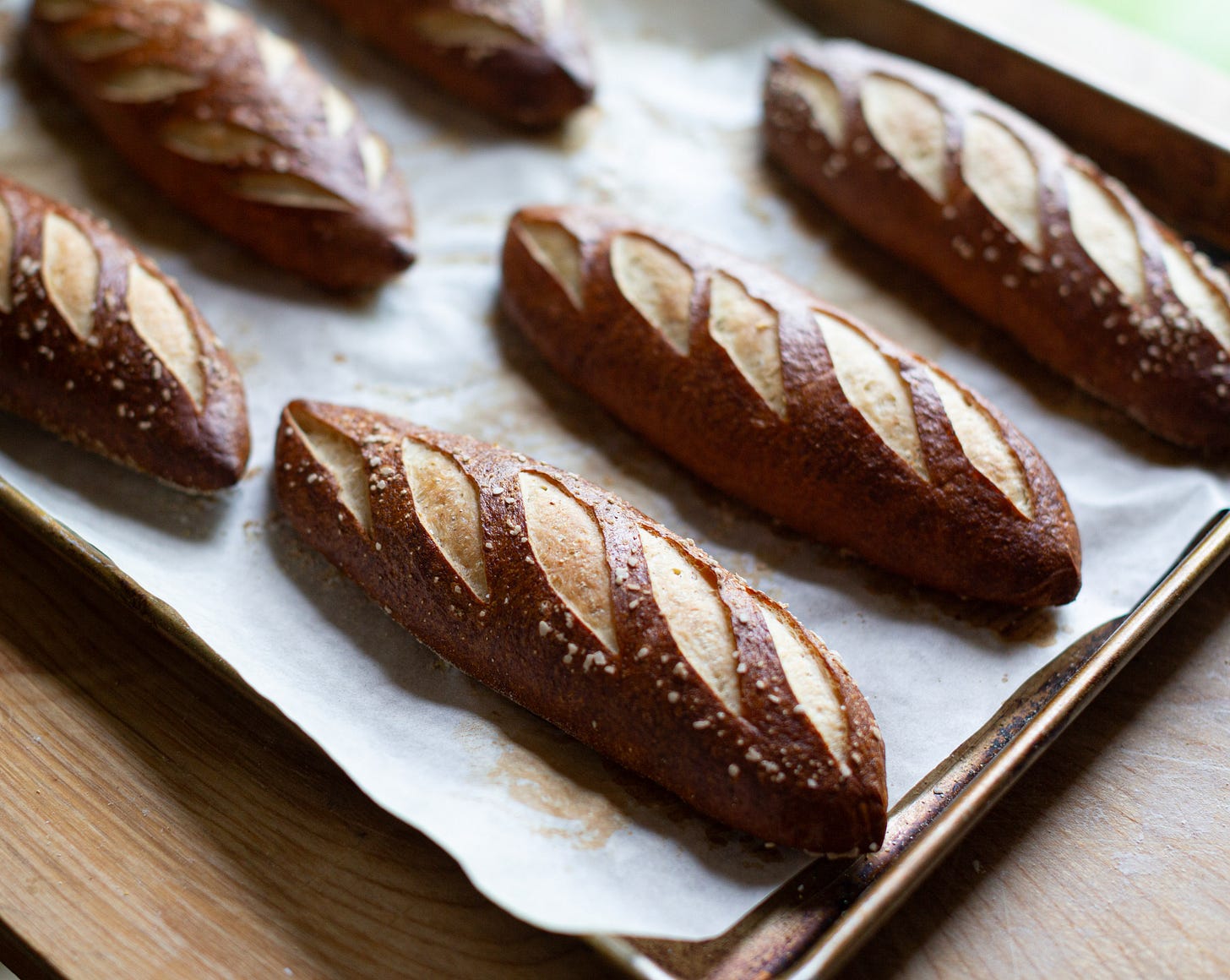


I've always used baking soda, but if I were to try lye does that solution also get boiled or just dip at room temperature? Are there any safety precautions that should be taken? My understanding of lye is solely informed by the Fight Club movie lol.
I love your recipe and I'm wondering if it's possible to substitute the butter with a neutral oil like canola. Would that work?